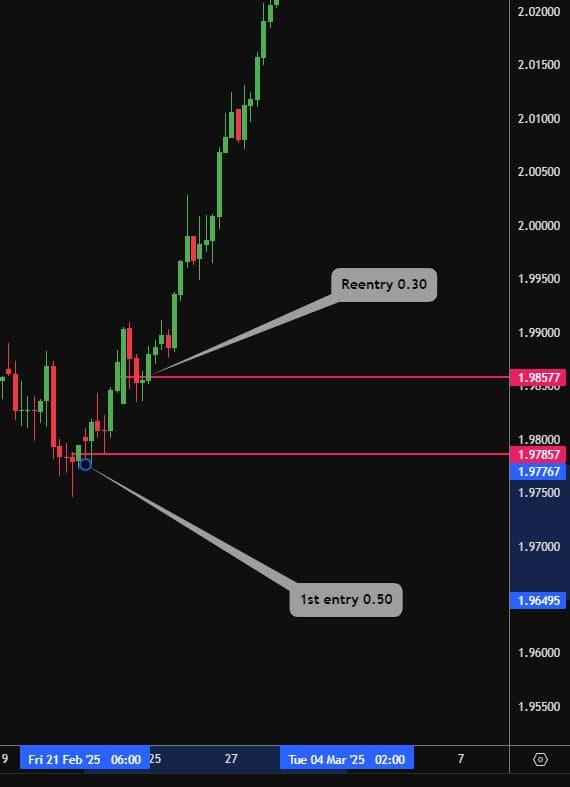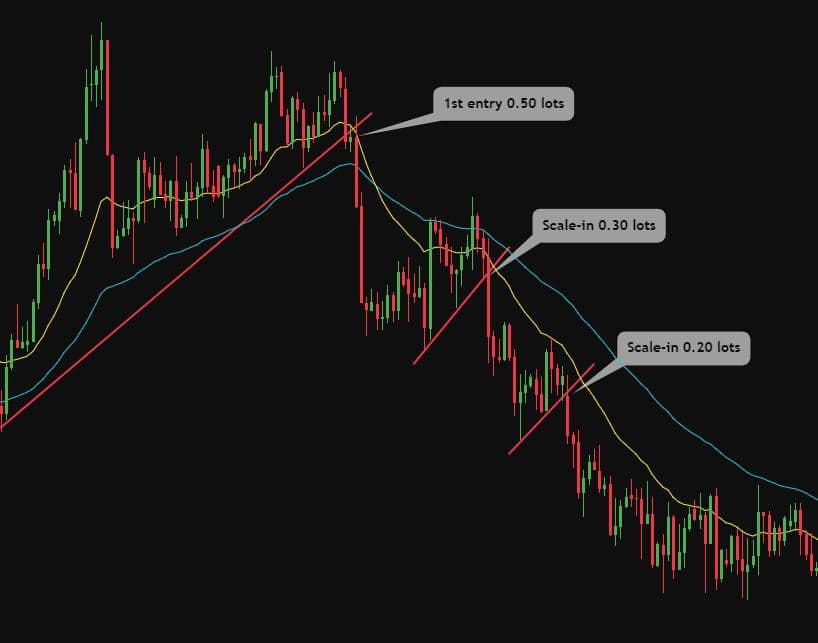
WHAT IS SCALING-IN? and WHY NEED TO LEARN IT
SCALE IN or SCALING-IN is a trading technique where you enter a position gradually instead of all at once. This strategy is used to manage risk and improve average entry price as the market moves in your favor or toward your anticipated entry zone.
What Is Scaling In?
Scaling in = entering partial positions at different price levels, instead of a single large entry.
Example:
You want to buy EUR/USD and expect price to reverse between 1.0700 and 1.0600.
Instead of entering 1.00 lot at 1.0700, you might:
- Buy 0.30 lots at 1.0700
- Buy 0.30 lots at 1.0650
- Buy 0.40 lots at 1.0600
Also, scale-in can be done as reentry but reducing the 2nd lot a bit smaller than the first one. The stoploss is same at first entry. 2nd reentry must smaller as it has big stoploss compare the first entry. So if it hit SL, the losses will be minimum.
Example:
You want to enter long/buy on GBPAUD. You want to buy GBPAUD at 1.9785. Then the price going up to 1.9900, retrace a bit at 1.9857 before going higher.
- First entry 0.50 lots at 1.9785
- 2nd reentry 0.30 lots at 1.9857
Note: You can scale-in up to for reentry depends on situasion.

Scaling-in or reentry for 2nd and 3rd lots must smaller than the first one. This is effective in money and risk management when all of the trade is failed.
Example;
Entry #1 – 0.20 standard lot, stoploss is 30 pips
Entry #2(scale-in) – 0.10 standard lot, reentry after price move 20 pips away from entry #1.
- Stoploss #1 is 30 pips. Stoploss #2 is 50 pips.
- Entry #1 is losses -$60 and entry #2 is loss -$50.
- Note – Loss from 2nd entry is not exceeded entry #1 because the lot size is reduced.
Scaling-in is not layering
Scaling-in is not layering entry because layering entry is total out from good money management. Proper layering should be as below;

Not too much entry in same place because rather than a same lot in same entry, it’s better to enter a huge lot once in one place. Think of logic, what’s the different opening 10x lot of 0.10 at 1.1100 and entering sell 1.00 at 1.1100?
It’s actually same thing except, the trade is closed at different price.
Example:
- 1st lot close at 1.1180,
- 2nd lot close at 1.1170,
- 3rd lot close at 1.1160….etc.
What I see is when people open so many lots in same price is no more than entering with full of emotion. You should know that trading with emotion is dangerous and could expose the trade in huge risk.
Why Use Scale-In?
| Reason | Benefit |
|---|---|
| Uncertain Entry Timing | Increases chance of catching the move within your zone |
| Reduce Risk | Smaller exposure if market goes against you early |
| Better Average Price | Can improve entry cost if done correctly |
2 Main Approaches
1. Scale-In During Pullback (Market is already moving in your direction)
- Used for trend continuation strategies
- Add to your position on minor retracements
- Ideal for pyramiding profitably
Example: Buy more after each bullish breakout and small retracement.
2. Scale-In Into a Zone (Market is against you but within expected area)
- Used when entering a reversal zone
- Gradual entries across support/resistance or Fibonacci zones
- Must have a clear invalidation level (stop loss area)
How to Scale In Correctly
- Define Your Total Risk (e.g. 1% of your account)
- Distribute this risk across multiple entries
- Never increase total risk beyond your plan
- Pre-plan Your Entry Levels
- Use SNR zones, Fibonacci levels, or EMAs
- Example: 3 levels = 33% entry each or weighted (e.g. 30%, 30%, 40%)
- Have a Clear Stop Loss
- Must define where the setup is invalidated (e.g. below last support)
- SL is based on the whole position, not each entry
- Manage Your Average Price
- Entry price shifts as you scale in
- Make sure new entries improve your setup, not worsen it
- Use a Break-even or Trail Strategy
- Once price moves in your favor, move SL to break-even
- Lock profits and reduce risk exposure
Common Mistakes to Avoid
| Mistake | Why It’s Dangerous |
|---|---|
| No Max Risk Limit | You could blow your account if market keeps going against you |
| Random Scaling | Without a plan, your average entry may be worse |
| Overconfidence | Scaling in isn’t a way to “fix” a bad trade |
| No Exit Plan | Scaling in requires even more discipline on exit points |
Summary: How to Scale In Correctly in Trading
Scaling in means entering a trade in parts instead of going all-in at once. It helps reduce risk, improve average entry, and gives flexibility when timing the market.
Why Use Scale-In?
- Reduces risk if the market moves against you early.
- Improves entry price if done within a planned zone.
- Helps manage large positions safely.
How to Scale In Properly:
- Set Total Risk – Decide your maximum risk (e.g. 1%).
- Plan Entry Levels – Use zones like SNR, Fibonacci, or EMAs.
- Use One Stop Loss – Based on the overall setup, not per entry.
- Watch Your Average Price – New entries should improve it.
- Protect Your Capital – Use break-even and trailing stops as needed.
Avoid These Mistakes:
- Don’t scale in without a clear risk limit.
- Don’t chase losses by adding randomly.
- Don’t skip exit planning just because you’re scaling.
Scaling in is a smart strategy only when done with discipline, planning, and clear rules. It gives traders better control over entries, especially in uncertain or volatile markets.
ADMIN
08/07/25



